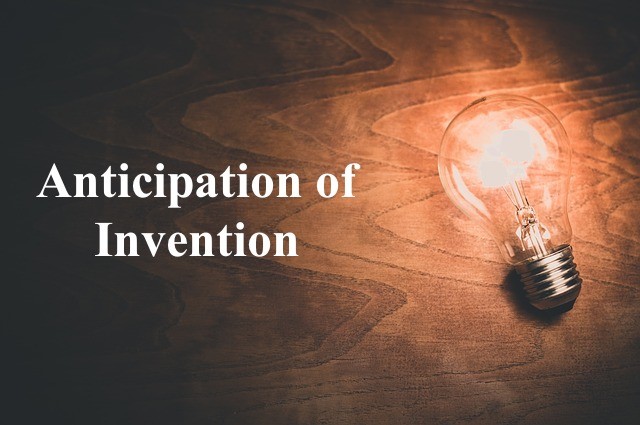Novelty is an important parameter to assess the patentability of any invention. Novelty is assessed on the basis that the subject of the invention is not anticipated. Here Novelty actually means “new compared to prior art”;
For an invention to be patentable, it must be different from all published articles, known techniques, and marketed products. The invention must not already have been made available to the public, when the filing of the application for a patent takes place.
Here an invention literally means “finding out something which has not been found by others”. A patent represents a quid pro quo (a favour or advantage granted in return for something). As a result the patentee gets monopoly over his invention.
Talking about the patent law, here anticipation talks about the prior invention or disclosure of the claimed invention by another, or the inventor’s own disclosure of the claimed invention sale, publication, or offer to sell prior to the inventor’s application for a patent. In simple words, if someone else knows about or used the invention before the patent applicant applies for a patent, then that patent applicant will not be eligible for patent.
The subject matter of a patent application can fall in the public domain and make it anticipated via either prior publication in patent or any kind of non-patent literature, or by display in public, use, or commercial sale. Grace period may be available in certain countries within which if a patent application is filed then it is not considered as anticipation.
Anticipation is considered as a parameter for rejecting or invalidating a patent since it signifies that the invention that is claimed lacks novelty.
In Lewmar Marine Inc. v. Barient Inc. (3 U.S.P.Q. 2d 1966(Fed. Cir. 1987)),‘that which would literally infringe if later in time anticipate if earlier than the date of invention’. Similarity will negate novelty and constitute anticipation.
For the anticipation to happen the prior publication has to cover almost every element of the claim in context. One cannot and should not look to one aspect in one publication and the rest amongst other publications.
So, also to be anticipation, a prior patent must include all the teachings necessary to accomplish what the allegedly invalid patent succeeds in doing. A disclosure could not make an invention available unless the invention could be made using the disclosure and also it would be the result of the disclosure.
The constitution of anticipation is different for different countries. It generally depends upon either the availability or absence of a grace period. There are some countries with 12 months grace period or 6 months grace period. A one year grace period provision is available for the US, for disclosures by someone who obtained the disclosed subject matter directly or indirectly from the inventor or a joint inventor, and follows the principle of relative novelty. Whereas Europe has stricter requirements for determining anticipation. In Europe, there is no grace period except for a six-month period in instances of abusive obtaining or public display in official international exhibition.
The Indian patent law takes middle way and provides for grace periods in some conditions to evaluate anticipation. The Indian Patents Act mentions what are not anticipations in Sections 29 to 34, rather than defining anticipation. Exceptions are mentioned in the Indian Patent Act under which the patent application can be filed despite public disclosure, and such public disclosure will not be considered to have been anticipated. These are:
1. Anticipation by previous publication (Sec 29): If the invention has been published prior to filing of the patent application, if the applicant or the patentee proves that the matter published was obtained from him or any person from whom he derives title without his consent or the consent of any such person, then a complete specification filed shall not be deemed to have been anticipated.
2. Anticipation by previous communication to the government (Sec 30): If the invention has been communicated to the government or any person authorised by the government for the purpose of investigation of the invention, then a complete specification filed shall not be deemed to have been anticipated.
3. Anticipation by public display (Sec 31):If the invention has been displayed in an exhibition to which the provisions of the instant section has been extended by the Central Government; or the invention is described in a publication in consequence of display of the invention in such an exhibition; or the invention has been used by any person without the consent of the true and first inventor or a person deriving title from him after it has been displayed in such an exhibition; or disclosing the invention before a learned society or publishing the invention in the transaction of such society; provided the application is filed within 12 months from aforementioned public display, then a complete specification filed shall not be deemed to have been anticipated.
4. Anticipation by public working (sec 32): If the invention has been filed within 12 months after the invention has been publicly worked for the purpose of reasonable trial considering the nature of the invention, then a complete specification filed shall not be deemed to have been anticipated.
5. Anticipation by use and publication after provisional specification (sec 33): If the invention has been used and published after filing a provisional application, then a complete specification filed shall not be deemed to have been anticipated.
To conclude, one should file a patent application ideally prior to publicly disclosing the invention. However, in light of the provisions discussed above one can still contemplate patent application filing.
For a patent application filed under the Paris convention, public use or publication of an invention either in India or elsewhere after filing of the application in convention country will not amount to anticipation.



